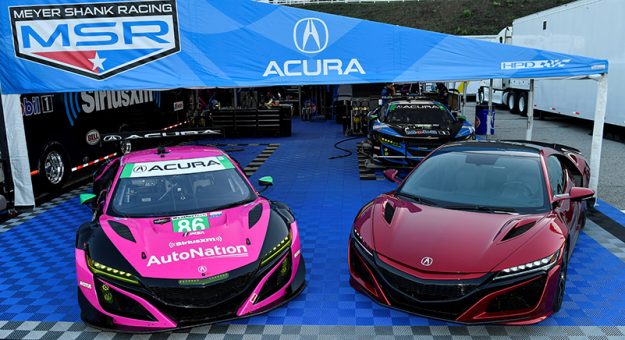By John Oreovicz
Have you ever dreamed about taking a supercar on an epic drive?

That dream came true for me recently when Acura and IMSA entrusted me to drive a new Acura NSX from my home in Indianapolis to Michelin Raceway Road Atlanta for the 23rd annual Motul Petit Le Mans.
I took the NSX out to run errands in a west Indianapolis suburb and was amazed how non-intimidating such an exotic looking car was to drive in city traffic. Outward visibility is excellent for a sports car, and in the ‘Quiet’ drive mode, the hybrid effect of the electric motors helped me average 35.5 miles per gallon of gasoline.
Of course, nobody buys (or borrows) a supercar to make runs to Best Buy. The real test of the NSX would come Wednesday on the drive to Michelin Raceway, and a rendezvous with the No. 86 Meyer Shank Racing with Curb-Agajanian Acura NSX GT3 that competes in the GT Daytona class of the WeatherTech Championship.
My ambitious goal was to drive both the Cherohala Skyway – a 43-mile National Scenic Byway across a mountain ridge between Tellico Plains, Tennessee and Robbinsville, North Carolina – and the legendary Tail of the Dragon. That’s an 11-mile stretch of US 129 at the Tennessee/North Carolina border that features 318 corners. This might be the only chance I ever get to experience these roads in a car like the NSX, so I was determined to get in as much quality driving as possible.
But before I could get to the good roads, there was the small matter of getting from Indianapolis to Tellico Plains, normally a 6-1/2-hour Interstate drive. There’s often no practical way to avoid the Interstate without a major time penalty, but with a bit of planning and creativity, you can minimize it.
 I elected to head south on I-65, but rather than veering east in Louisville on I-64, I continued on 65 to Cave City, Kentucky. This 200-mile stretch of Interstate confirmed what a civilized machine the NSX is.
I elected to head south on I-65, but rather than veering east in Louisville on I-64, I continued on 65 to Cave City, Kentucky. This 200-mile stretch of Interstate confirmed what a civilized machine the NSX is.
It’s a little louder than a family sedan or SUV, but it doesn’t follow tramlines or wander in its lane. It feels solidly connected to the ground, yet the ride is amazingly supple. It’s as easy to guide down the highway as a Honda Civic or Accord.
Even though the interior is clearly special, with handcrafted leather and Alcantara trim, there is a “normalness” that instantly puts a driver at ease. Controls for the headlights, wipers, and cruise control are intuitive and located just where you expect them to be.
Exiting the Interstate, it was time to twist the large rotary knob on the console to select the ‘Sport’ drive mode, which creates quicker throttle response and a richer exhaust note. My favorite road is the empty road, and traffic finally cleared after I exited Glasgow on Kentucky State Highway 90. The rolling hills and gentile curves were perfect for a comfortable country cruise, through villages with names like Eighty-Eight and Summer Shade.
Turning south, Kentucky 163 took me into Tennessee, where I followed a series of State Highways before rejoining Interstate 40 at Monterey. A little under two hours later, I reached Tellico Plains, with an elapsed time of 7 hours flat. Half an hour was a small price to pay for trading the Interstate rat race for 150 miles of relaxed backroads touring.
The last time I drove the Cherohala Skyway (six years earlier to the day in a rental Ford Taurus), conditions were terrible – slashing rain, 50-mph wind, trees down in the road. The good news is that in 43 miles, I saw just one other car and was able to drive at my own (quick) pace. This year, the weather was glorious, and the Fall foliage was at its peak. Tourist weather. Traffic was therefore too heavy for spirited driving, but it offered yet another opportunity to marvel at the NSX’s ability to excel at any speed.
Upon reaching Robbinsville, it would have been all too easy to make the half-hour drive to the hotel and call it a day. But it was only 4:30 p.m., and there was plenty of daylight to come. Plus, I was in an Acura NSX. So, I turned north on US 129, and headed for Tail of the Dragon.
Enter the Dragon
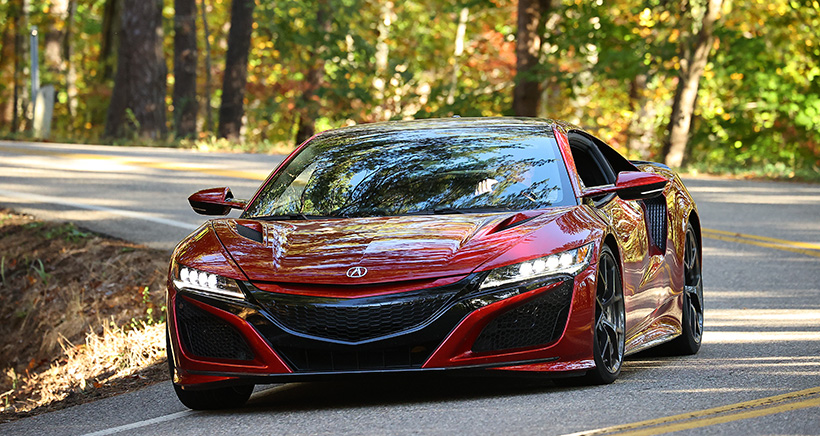
“This used to be our playground,” remarked a gentleman in the parking lot of the Deal’s Gap Motorcycle Resort, the unofficial southern starting point of the Tail. He was a local, hauling his trash to the landfill in a spiffy new RAM truck. “About 20 years ago, the secret got out.”
Indeed, Tail of the Dragon is a Destination Drive, often mentioned in the same breath as the Nurburgring Nordschleife (where tourists can pay 25-30 Euros to drive a lap of the famous German racing circuit) or Col de Turini, a mountain pass in French Alps notably used as a stage in the Monte Carlo Rally. For driving enthusiasts, this is hallowed asphalt.
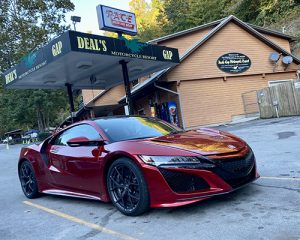 It’s not for tourists, or the faint of heart. “This is not a road to sight-see on,” comments one of the many websites devoted to the Tail. “The attraction is the road itself, not the scenery…the curves are what you should be concerned with.”
It’s not for tourists, or the faint of heart. “This is not a road to sight-see on,” comments one of the many websites devoted to the Tail. “The attraction is the road itself, not the scenery…the curves are what you should be concerned with.”
Good advice, because those 318 corners come at you in relentless fashion. There’s no such thing as a “straight” on Tail of the Dragon, and only the fastest cars and motorcycles will ever see the high side of 60 miles per hour. But you’ll feel like you’re going twice as fast.
Engaging Sport+ drive mode, the suspension and steering are recalibrated for more aggressive handling. The already superb steering becomes even more communicative. Coupled with the explosive acceleration and impressive braking, the NSX inspires confidence and makes an everyday driver look like a hero.
According to Tennessee Department of Transportation figures, around 1,200 vehicles travel Tail of the Dragon on an average day. The odds of getting a clear run up or down all 11 miles are long. But even a three- or four-mile stretch of unimpeded driving is absolutely exhilarating, the closest you can get to being on a racetrack or rally stage on public roads.
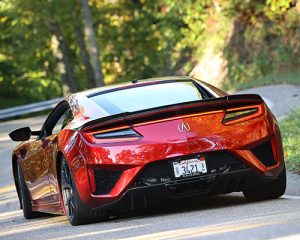 At one point on the way back down, I let a guy on a sport bike past me and followed him for a couple miles until we caught up to a slow SUV. He clearly knew the road well, and his lean angles were ample demonstration of his commitment. I certainly didn’t keep up with him, but I was pleased to keep him in sight while still driving well within my limits. All credit to the NSX.
At one point on the way back down, I let a guy on a sport bike past me and followed him for a couple miles until we caught up to a slow SUV. He clearly knew the road well, and his lean angles were ample demonstration of his commitment. I certainly didn’t keep up with him, but I was pleased to keep him in sight while still driving well within my limits. All credit to the NSX.
It’s not a car for wallflowers. Kids wave, other drivers honk their horns, and everyone you encounter at a gas station or rest area wants to know about it. “How much? How fast? How fun?”
The amazing thing about the NSX is its ability to do it all. From docile Interstate cruising to eight-tenths hustling on treacherous mountain roads, the NSX handles every situation with style and grace. It’s never temperamental or high strung, operating with the reliable precision of any Honda product.
Truly the everyday supercar.
About the NSX, A History Lesson
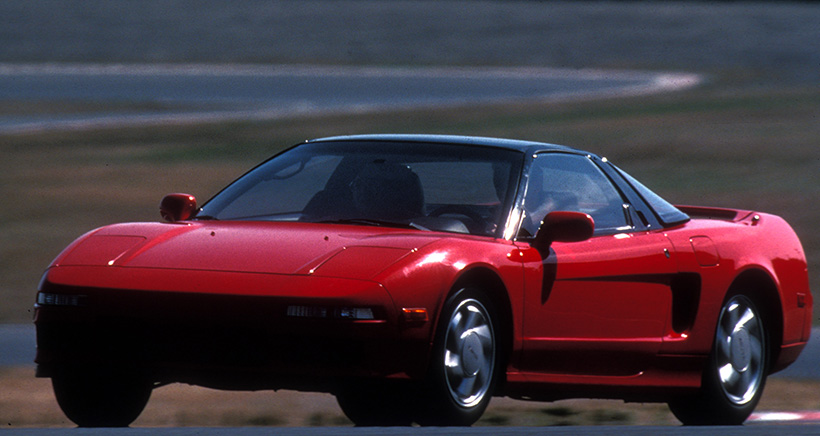
The NSX is a halo car, the culmination of more than 70 years of passion, pride and progress for the Honda Motor Company and its Acura division. The first generation NSX was produced from 1990-2005, immediately gaining a reputation as an “everyday supercar.” It combined performance that could match exotic cars from anywhere in the world with an unprecedented level of practicality and drivability for a high-end sports car.
The original NSX spun off special editions inspired and developed by Formula 1 legend Ayrton Senna and Indy car champion/Paralympic athlete Alex Zanardi. The NSX also served as the basis for an iconic racing car that competed for many years in the Japanese Super GT championship.
The second generation NSX debuted at the 2015 North American International Auto Show in Detroit. Designed by Honda associates in America and hand built at the Performance Manufacturing Center in Marysville, Ohio, the Mk II NSX ups the technological ante with a suite of components collectively called Sport Hybrid Super Handling All-Wheel Drive (SH-AWD). The new model combines a mid-mounted 3.5-liter twin turbo V-6 engine mated to a 9-speed dual clutch transmission, assisted at the back by a 47-horsepower Direct Drive Motor that features a hybrid function to capture energy.
Up front, a Twin Motor Unit includes two electric motors that independently regulate the front wheels, creating an active, torque vectoring AWD system that improves handling and also contributes to regenerative braking force while also replenishing the hybrid battery function. Altogether, the NSX produces 573 horsepower and 476 lb.-ft. of torque, supercar numbers by any measure.
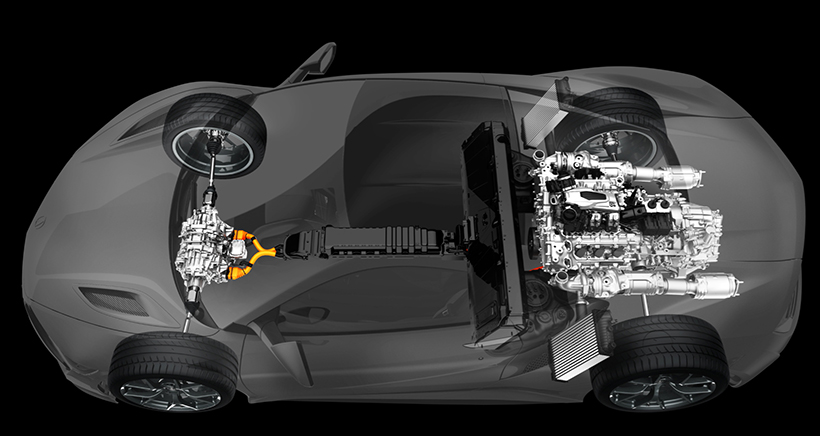
All in the Family
The final stint of my drive from Indianapolis to Michelin Raceway Road Atlanta in an Acura NSX was uneventful, a little over two hours from Bryson City, North Carolina. At one point, I missed a turn, and it turned into a happy accident.
The recalculated route took me through the most vivid foliage of the trip on U.S. 64 through the Nantahala National Forest, then down Georgia State Highway 17. This was another great driving road, winding through the town of Helen (population 430, known as “Georgia’s Alpine Village”) and what looked like an amazing Oktoberfest. That’s the kind of thing you never discover when you stick to the Interstate, and the NSX returned nearly 29 mpg in relaxed back road touring mode.
Naturally, I was sad to give up the key fob to the NSX, but I was also relieved that I had completed 800 miles of often spirited driving without incident or a speeding ticket. There’s a certain element of stress in being the keeper of a $170,000 supercar, no matter how much fun you are having behind the wheel.
Upon arrival in Atlanta, I swapped out the NSX, exchanging it for a Honda Ridgeline for my drive home. The NSX was shuttled into the IMSA paddock “bubble” for a photo opportunity (main photo) with the No. 86 Acura NSX GT3 campaigned by Meyer Shank Racing with Curb-Agajanian in the GT Daytona class of the IMSA WeatherTech SportsCar Championship.
Honda founder Soichiro Honda firmly believed that racing was the best way to develop people and technology, and that tradition carries on through this day within the Honda and Acura Racing programs.
The NSX GT3 was designed and developed alongside the NSX street car, and they share a surprising number of components, starting with the aluminum space frame chassis. The production car is skinned in aluminum, while the racing bodywork, with additional aerodynamic aids and apertures for cooling, is crafted from carbon fiber.
Hybrid technology is not currently permitted in the IMSA GTD class or other worldwide GT3 competition, so the NSX GT3 uses a lightly modified version of the street NSX’s 3.5-liter V-6 to send power to the rear wheels only through a racing gearbox with sequential shift. The engine block, heads, crankshaft, pistons, and dry sump lubrication system in the racing powerplant are all OEM components, with light modification. The twin turbochargers feature upgraded bearings and propellors in stock housings, along with stock intercoolers. In all, the NSX and NSX GT3 have about 80 percent parts commonality.
The racing-specification engine produces 550 horsepower, actually slightly less than the total output of 573 horsepower from the street NSX’s hybrid powertrain. But the racing car weighs just 2,800 pounds, almost 1,000 pounds fewer than the production model.
Acura produced a fascinating video that featured 2019 GTD champion Trent Hindman (above) comparing the performance of the road and racing versions of the NSX in a variety of tests. Surprisingly, the street car, aided by all-wheel drive and the instant torque from the supplemental electric motors, is much faster accelerating from 0-60 miles per hour. But the NSX GT3 is convincingly faster over a lap of a road course.
It’s amazing to think that the 3.5-liter twin turbo engine in the Acura Team Penske Acura ARX-05 that leads the Daytona Prototype international (DPi) class of the WeatherTech Championship shares major components including engine block, cylinder heads, crankshaft, camshafts, valves and rockers, and water pump with the J35 family of engines that power many popular Honda and Acura cars, trucks and SUVs.
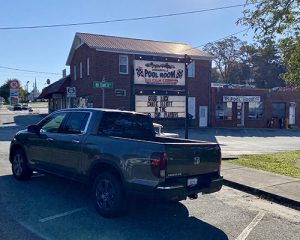 In that way, the Ridgeline truck that I drove home from Road Atlanta has as much in common with a racing car as the NSX that I drove to the Motul Petit Le Mans.
In that way, the Ridgeline truck that I drove home from Road Atlanta has as much in common with a racing car as the NSX that I drove to the Motul Petit Le Mans.
A Honda Ridgeline and an Acura NSX couldn’t be much more different, but they shared one other interesting similarity. Both averaged 23.5 miles per gallon of fuel. Talk about two radically different ways to achieve the same result!
The trip home to Indianapolis was mostly on the Interstate, unpleasantly crowded and occasionally stopped by construction backups. Not my favorite kind of driving.
But nine times out of 10, whether it’s in a pickup truck or a supercar, I’d still rather drive than fly.
